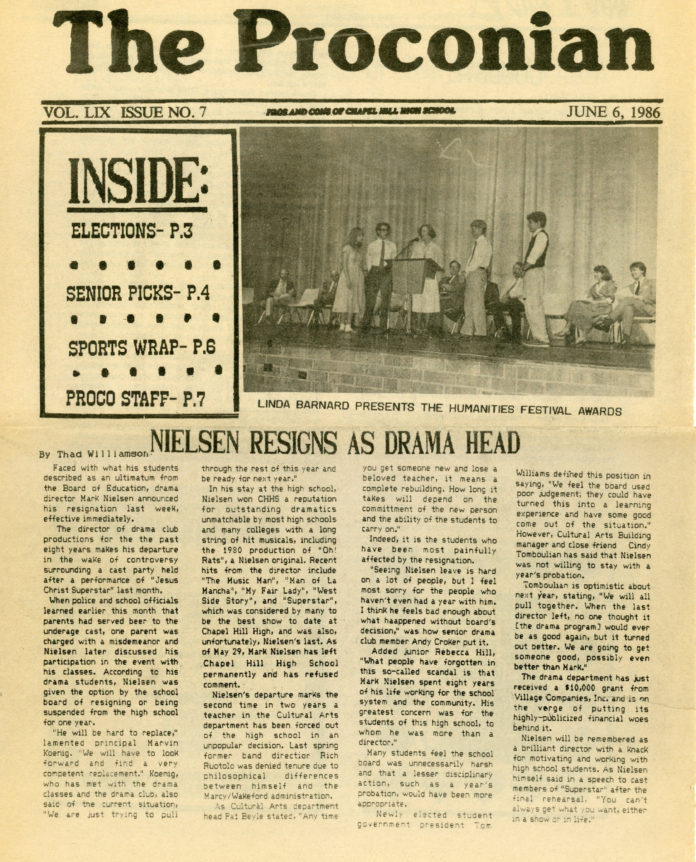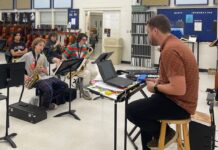Proconian, Chapel Hill High School’s print newspaper, is going digital. The 86-year-old publication will move to an online format after this issue, publishing stories on its website in order to cut costs.
The Proconian Club published the first issue of the Proconian on January 22, 1931, intending to publish a newspaper semimonthly. The Daily Tar Heel covered the “attempt” three days later, noting that the title “signifies that the paper does not intend to be partisan, but rather that it will give both sides of a question, hence the pro and con name.”
During the first years of its publication, Proconian was mimeographed stenciled onto 8 1⁄2” by 11” sheets of paper and became weekly in 1934, costing 40 cents for a four-month subscription.
Several issues were professionally printed in 1943 before returning to mimeography due to war shortages. The first regular year of printing was 1944, when Proconian became the only high school paper to be printed weekly in North Carolina. After 1948, Proconian was printed twice a month, and as a 1957 issue noted, the “paper’s size increases with age.” It would later take on a broadsheet format, and its frequency has since dwindled.
The Proconian newspaper used to be funded through the school; however, in recent years Proconian class members have had to pay for expenses through subscriptions, ad selling and fundraising.
“[Proconian] was a learning experience that served me well. It was fun working with peers to write and come up with article ideas on different sports,” Davis Boyle, a Spanish teacher at Chapel Hill, said. Boyle was the sports editor in 1999, his senior year. “Technologically speaking, it was challenging because we were working on very old Macs that were impossible to work with,” he said.
Andrew Cohen, father of Chapel Hill senior Lena Cohen, was the editor-in-cheif of Proconian in 1980-1981 and commented on how different newspaper production was at the time. “We had a word processor that would spit out columns of text, and we’d have to cut them out by hand and paste them in the right layout,” he said.
In the modern era, many print publications have moved to be solely digital. Newsweek was one of the first news magazines to transition to an exclusively digital format in 2012, though it later returned to limited print. In 2017 Village Voice also moved online.
A study conducted by Roosevelt University’s College of Communication found that in 1990, almost all of Chicago public high schools had a school newspaper. By 2006, the number had dropped to about 60 percent.
The University of North Carolina’s (UNC) student-run newspaper The Daily Tar Heel stopped printing on Tuesdays and Thursdays in 2016 due to financial pressure and lack of student interest.
Jared Weber, 2015-2016 Proconian editor-in-chief and current UNC journalism major, finds that the newspaper’s move to a digital format is inevitable in the current age. “Through my classes at UNC and my time at [Proconian], I’ve started to see how difficult it is to maintain print publication,” Weber said. “I think it’s a shame.”
Will Guzzardi, 2004-2005 Proconian editor-in-chief and current Illinois State Representative, also sees benefits to print journalism. “I think there’s value in the print edition. It gives the paper a connection to its storied history; it gives students and the community something to hold onto and pass around,” Guzzardi said.
Other notable Proconian alumni include writer Wells Tower and editor-in-chief of SELF magazine Carolyn Kylstra.
An online Proconian will allow student journalists to publish their stories as soon as they are finished, without having to worry about print space or photographic limitations. Digital media, such as photo albums and video, will also become a possibility. The new website to access the Proconian is www.proconian.com.
Additional reporting by Max Kurzman












